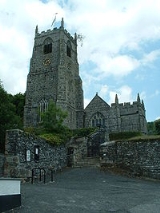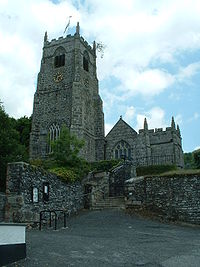
St Neot
Encyclopedia
St Neot is a civil parish and village in Cornwall
, England, United Kingdom. It is situated between the towns of Bodmin
and Liskeard
.
The parish is named after the Saxon
monk
, Saint Neot
(who also gives his name to St Neots
in Cambridgeshire
, whence his alleged bones were taken in the early Middle Ages). On the northern side the parish includes part of Bodmin Moor
and hamlets in the parish include Draynes, Ley and Pantersbridge.
St Neot was staunchly Royalist
. To commemorate this, each year on Oak Apple Day
(29 May), an oak branch is mounted on the top of the church tower to symbolise the historical allegiance.
Henry Dangar
(1796–1861) was a native of St Neot who became a surveyor and explorer of Australia.
 The original dedication may have been to 'St Anietus', with whom the Saxon Neot has been confused. In the 11th century a small monastery existed here; the early medieval church building (of which the tower remains) must have been smaller than the one in existence today. Rebuilding in granite was undertaken in the 15th century and the fine stained glass windows are from about 1500.
The original dedication may have been to 'St Anietus', with whom the Saxon Neot has been confused. In the 11th century a small monastery existed here; the early medieval church building (of which the tower remains) must have been smaller than the one in existence today. Rebuilding in granite was undertaken in the 15th century and the fine stained glass windows are from about 1500.
The stained glass is partly original and partly from a restoration done by John Hedgeland, ca. 1830
Nearby is the holy well of St Neot. Legend tells that the well contained 3 fish, and an angel told St Neot that as long as he ate no more than one fish a day, their number would never decrease. At a time St Neot fell ill, and his servant went and cooked 2 of the fish; upon finding this, St Neot prayed for forgiveness and ordered that the fish be returned to the well. As they entered the water, both were miraculously returned to life.
main line.
In 2004 and 2006, the village of St Neot won the National Calor Village of the Year
award. St Neot also won the Calor Gas Village of the Decade award, which celebrated 10 years of the competition
The nearby Carnglaze Caverns
, a former slate quarry, forms an unusual music venue.
). Lewarne is a neo-Tudor country house built for the Grylls family in 1869. Langdon (1896) records six stone crosses in the parish, of which three are at the vicarage.
Cornwall
Cornwall is a unitary authority and ceremonial county of England, within the United Kingdom. It is bordered to the north and west by the Celtic Sea, to the south by the English Channel, and to the east by the county of Devon, over the River Tamar. Cornwall has a population of , and covers an area of...
, England, United Kingdom. It is situated between the towns of Bodmin
Bodmin
Bodmin is a civil parish and major town in Cornwall, England, United Kingdom. It is situated in the centre of the county southwest of Bodmin Moor.The extent of the civil parish corresponds fairly closely to that of the town so is mostly urban in character...
and Liskeard
Liskeard
Liskeard is an ancient stannary and market town and civil parish in south east Cornwall, England, United Kingdom.Liskeard is situated approximately 20 miles west of Plymouth, west of the River Tamar and the border with Devon, and 12 miles east of Bodmin...
.
The parish is named after the Saxon
Anglo-Saxons
Anglo-Saxon is a term used by historians to designate the Germanic tribes who invaded and settled the south and east of Great Britain beginning in the early 5th century AD, and the period from their creation of the English nation to the Norman conquest. The Anglo-Saxon Era denotes the period of...
monk
Monk
A monk is a person who practices religious asceticism, living either alone or with any number of monks, while always maintaining some degree of physical separation from those not sharing the same purpose...
, Saint Neot
Saint Neot
Neot is a saint of the 9th century who lived as a monk in Cornwall. He is mentioned in an interpolated passage in Asser's Life of King Alfred and died around AD 870....
(who also gives his name to St Neots
St Neots
St Neots is a town and civil parish with a population of 26,356 people. It lies on the River Great Ouse in Huntingdonshire District, approximately north of central London, and is the largest town in Cambridgeshire . The town is named after the Cornish monk St...
in Cambridgeshire
Cambridgeshire
Cambridgeshire is a county in England, bordering Lincolnshire to the north, Norfolk to the northeast, Suffolk to the east, Essex and Hertfordshire to the south, and Bedfordshire and Northamptonshire to the west...
, whence his alleged bones were taken in the early Middle Ages). On the northern side the parish includes part of Bodmin Moor
Bodmin Moor
Bodmin Moor is a granite moorland in northeastern Cornwall, England, United Kingdom. It is in size, and originally dates from the Carboniferous period of geological history....
and hamlets in the parish include Draynes, Ley and Pantersbridge.
History
During the English Civil WarEnglish Civil War
The English Civil War was a series of armed conflicts and political machinations between Parliamentarians and Royalists...
St Neot was staunchly Royalist
Cavalier
Cavalier was the name used by Parliamentarians for a Royalist supporter of King Charles I and son Charles II during the English Civil War, the Interregnum, and the Restoration...
. To commemorate this, each year on Oak Apple Day
Oak Apple Day
Oak Apple Day or Royal Oak Day was a holiday celebrated in England on 29 May to commemorate the restoration of the English monarchy, in May 1660...
(29 May), an oak branch is mounted on the top of the church tower to symbolise the historical allegiance.
Henry Dangar
Henry Dangar
Henry Dangar was a surveyor and explorer of Australia in the early period of British colonisation. He became a successful pastoralist and businessman, and also served as a magistrate and politician...
(1796–1861) was a native of St Neot who became a surveyor and explorer of Australia.
Parish Church of St Neot

The stained glass is partly original and partly from a restoration done by John Hedgeland, ca. 1830
Nearby is the holy well of St Neot. Legend tells that the well contained 3 fish, and an angel told St Neot that as long as he ate no more than one fish a day, their number would never decrease. At a time St Neot fell ill, and his servant went and cooked 2 of the fish; upon finding this, St Neot prayed for forgiveness and ordered that the fish be returned to the well. As they entered the water, both were miraculously returned to life.
Transport and Village Award
No railway was ever built to the village, despite pressure from local people and mine owners in the 1860s and 1870s. Instead, Doublebois railway station was opened on 1 June 1860 about two miles south of St Neot on the Cornwall RailwayCornwall Railway
The Cornwall Railway was a broad gauge railway from Plymouth in Devon to Falmouth in Cornwall, United Kingdom. The section from Plymouth to Truro opened in 1859, the extension to Falmouth in 1863...
main line.
In 2004 and 2006, the village of St Neot won the National Calor Village of the Year
Calor Village of the Year
The Calor Village of the Year comprised 4 annual competitions organised by gas provider Calor to identify the villages that best met the following criteria: "a well-balanced, pro-active, caring community which has made the best of local opportunities to maintain and enhance the quality of life for...
award. St Neot also won the Calor Gas Village of the Decade award, which celebrated 10 years of the competition
The nearby Carnglaze Caverns
Carnglaze Caverns
Carnglaze Caverns consists of three man-made caverns formed as part of a slate quarry in the Loveny Valley, near the village of St Neot, Liskeard, Cornwall, England...
, a former slate quarry, forms an unusual music venue.
Other notable buildings
Two 15th century bridges are at Pantersbridge and Treverbyn (crossing the Warleggan and Fowey riversRiver Fowey
The River Fowey is a river in Cornwall, United Kingdom.It rises about north-west of Brown Willy on Bodmin Moor, passes Lanhydrock House, Restormel Castle and Lostwithiel, then broadens at Milltown before joining the English Channel at Fowey. It is only navigable by larger craft for the last ....
). Lewarne is a neo-Tudor country house built for the Grylls family in 1869. Langdon (1896) records six stone crosses in the parish, of which three are at the vicarage.

